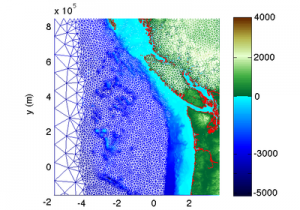Modelling the coastal effects of a Tsunami
Professor Serge Guillas of UCL’s Department of Statistical Science and also Met Office Joint Chair in Data Sciences for Weather and Climate Fellow at the Alan Turing Institute, is researching models for geophysics.
Through UCL’s membership of the Science & Engineering South (SES) Consortium, he has worked with GPU specialists in Oxford to greatly improve the performance of a tsunami simulation code. The team used the SES GPU-accelerated supercomputer, Emerald, to achieve its results.
Background
High-performance computing is an integral part of research aimed at modelling real-life phenomena. Recent, major tsunamis in Indonesia and Japan have caused the insurance industry and civil authorities around the world to demand better models to assess tsunami risk.
Dr Serge Guillas received proof-of-concept funding from UCL Business in 2012 to start quantifying tsunami risk in the Cascadia Region on the pacific coast of North America. This area is of major interest to the insurance industry
Dr Guillas is collaborating on a project to improve a tsunami modelling application called VOLNA. This application can produce high-quality results, but the high precision and scale of these models meant that simulations could take weeks to perform on a standard desktop computer. So, Dr Guillas worked with SES staff at the Oxford e-Research Centre to adapt the simulation code to run on cutting edge high-performance computers.
What we did
Via UCL’s membership of SES, Dr Guillas contacted Mike Giles and Istvan Reguly at Oxford. The Oxford team took on the task of porting VOLNA into the new framework: OP2. This allows VOLNA to run on a wide variety of CPU-GPU supercomputers (GPUs are Graphical Processor Units, a high-end version of the graphics card in a desktop PC). This work enables the simulation code to be parallelised to better take advantage of faster computer systems. The software remains as readable and maintainable as the original but can speed up the time taken to complete simulations by a factor of 3,000 to 8,000.
Additionally, by making use of supercomputers, such as Emerald, to run simulations across multiple GPUs, the calculations can be further accelerated by a factor close to the number of GPUs used. For example, a simulation that previously took 1 week to run in serial on a desktop PC can now be completed in around 5 minutes on Emerald using just two GPUs.
VOLNA uses a mesh of triangular areas to model the characteristics of the waves as they travel. Smaller triangles are used as tsunami waves approach the shore where greater precision is required.
Impact of the work
This work opens up new horizons for tsunami modelling and catastrophe prevention. It is now possible to simulate how tsunamis begin, grow and impact faster than real-time. This helps with early warnings to reduce loss of life and damage to property. The tsunami models currently in use for this purpose tend to either be too slow to simulate or too simple to be useful.
One of the key issues with prediction systems is the uncertainty about the exact characteristics of the earthquake that caused the tsunami. It helps to be able to run a number of simulations in parallel on a supercomputer such as Emerald because one can more accurately determine the likely range of outcomes.
Following the successful completion of the proof-of-concept stage of his work, Dr Guillas was later awarded £100k from the follow-on funding scheme from the Natural Environment Research Council (NERC) to make the system commercially viable. He collaborated with partners at Oasis Loss Modelling Framework as part of a wider initiative to create a framework for catastrophe loss modelling.
Further Reading and References
- The Alan Turing Institute: Uncertainty quantification of multi-scale and multi-physics computer models
- The Alan Turing Institute: Real-time data assimilation for Digital Twins
- Published paper on Sequential Design with Mutual information for computer experiments (MICE): Emulation of a tsunami model
- The original VOLNA code is described in this article http://hal.archives-ouvertes.fr/docs/00/58/52/11/PDF/DPD-2011.pdf
- There is some coverage in France of this model, with an article (in French) in “Science et Avenir” after a talk at ENS-Cachan on their large 3-D screen.
- To find out more about help available to researchers at UCL visit our ‘Help for UCL Researchers’ page.
Contact

Professor Serge Guillas
Met Office Joint Chair in Data Sciences for Weather and Climate Fellow, Alan Turing Institute Department of Statistical Science, University College London


